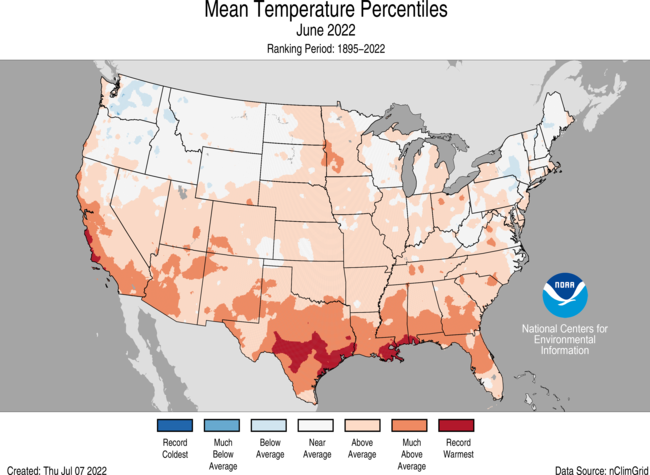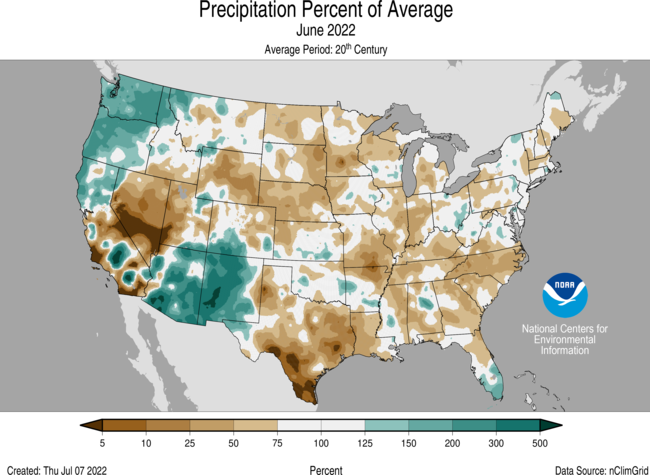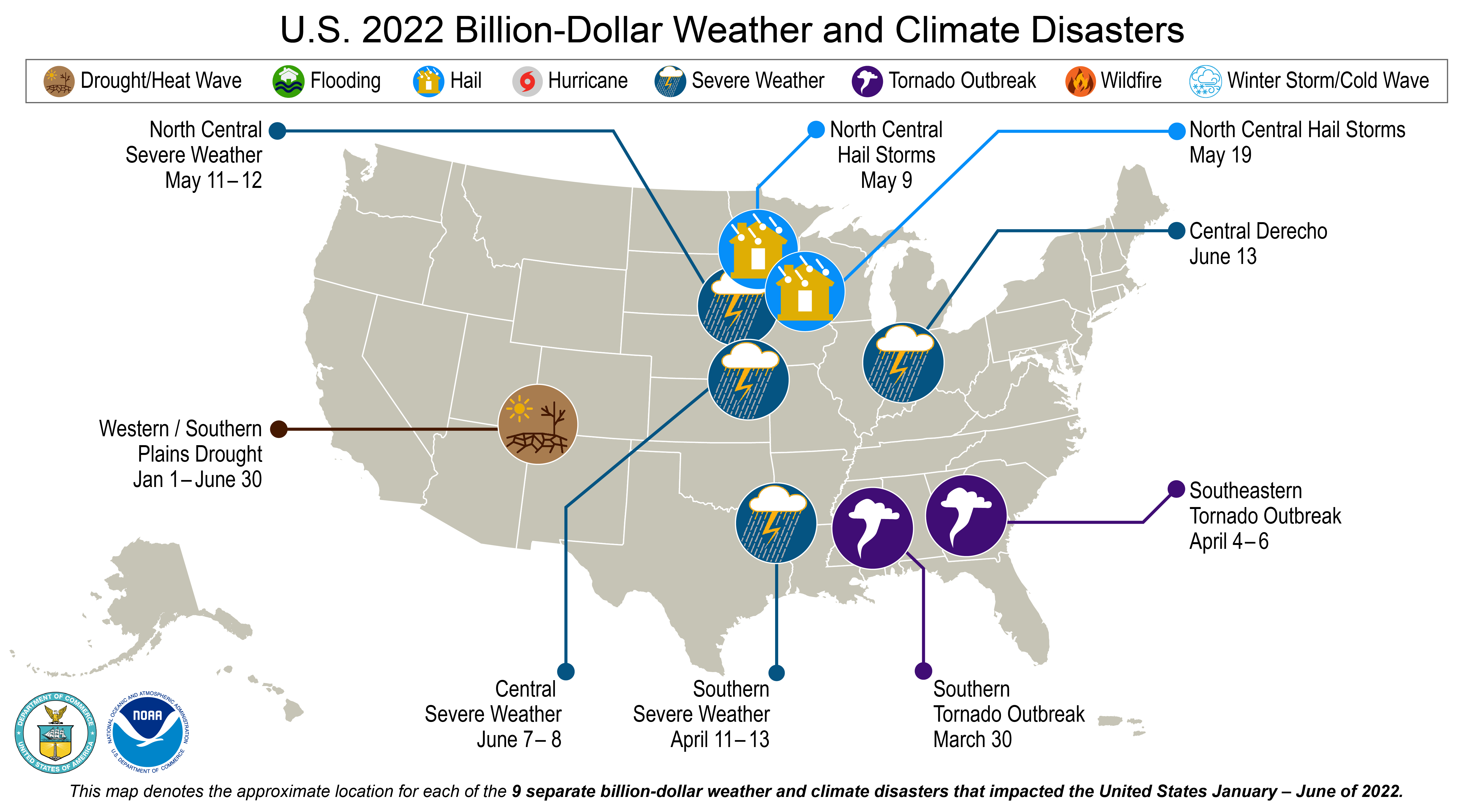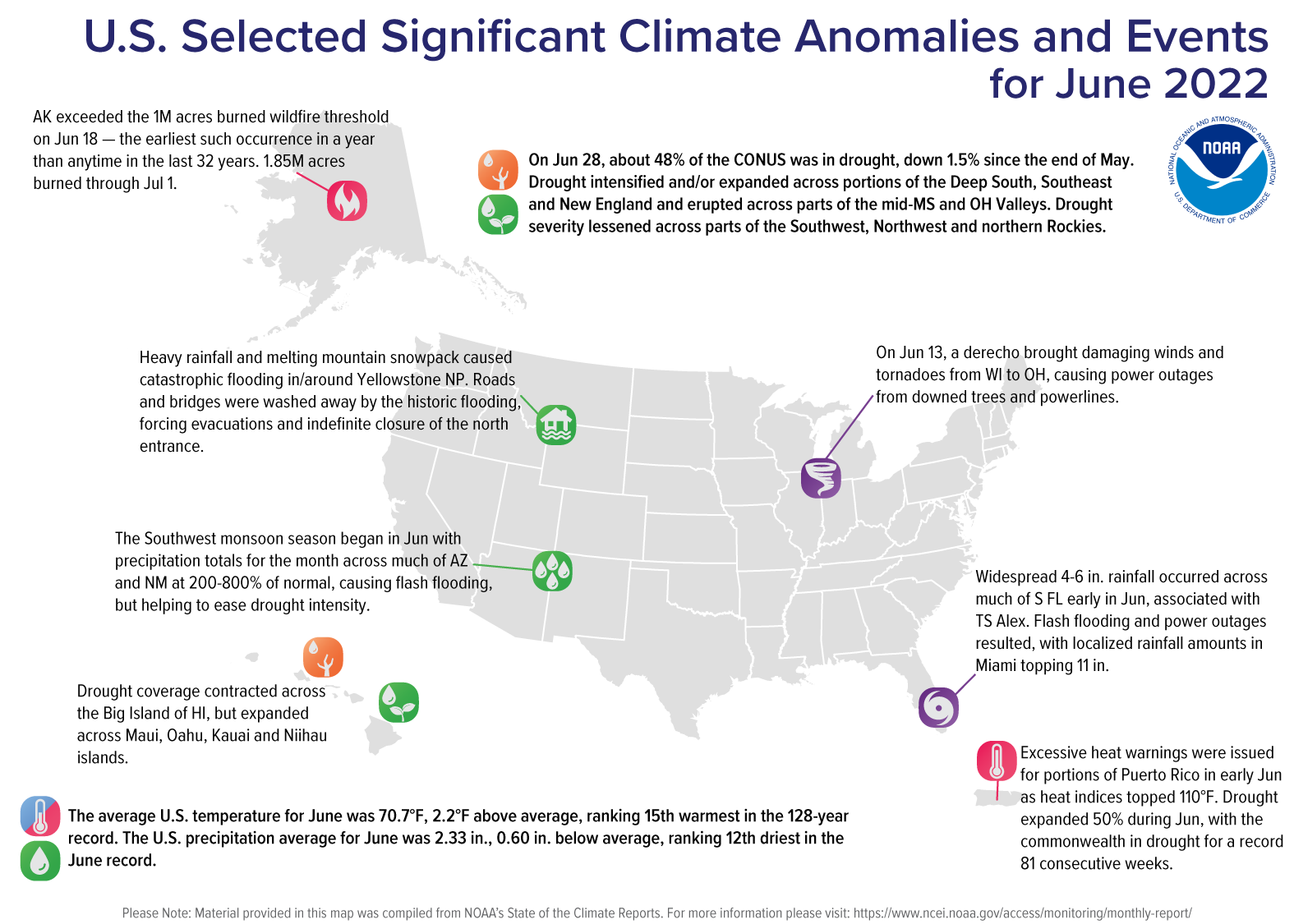June was Dominated by Remarkable Heat, Dryness
Top Stories
11 Jul 2022 1:45 AM
Storm damage in Berlin Township, Ohio, from a derecho that moved through the region on June 13, 2022. This derecho is one of nine billion-dollar disasters to strike the U.S. so far in 2022. (NOAA National Weather Service-Cleveland/Neil Fischer)
[Written by NOAA] June kicked off a very warm and dry start to meteorological summer for the U.S., according to experts from NOAA’s National Centers for Environmental Information.
The year so far also brought nine separate billion-dollar weather and climate disasters to the nation — including tornado outbreaks, damaging hail and extreme drought.
Below are more highlights from NOAA's U.S. monthly climate report for June:
 The average June temperature across the contiguous U.S. was 70.7 degrees F (2.2 degrees above average), making it the 15th-warmest June in 128 years.
Above-average warmth dominated much of the nation last month. Florida, Louisiana and Mississippi each had one of their top-10 warmest Junes on record, while Texas saw its fifth warmest on record. Alaska had its ninth-warmest June in the 98-year period of record for the state.
June precipitation across the U.S. was 2.33 inches — 0.60 of an inch below average — tying with 1930 as the 12th-driest June in the historical record.
Despite the below-average precipitation, some states saw a rather wet month. New Mexico had its fifth-wettest June on record, with Washington State and Oregon ranking seventh and eighth wettest, respectively.
The average June temperature across the contiguous U.S. was 70.7 degrees F (2.2 degrees above average), making it the 15th-warmest June in 128 years.
Above-average warmth dominated much of the nation last month. Florida, Louisiana and Mississippi each had one of their top-10 warmest Junes on record, while Texas saw its fifth warmest on record. Alaska had its ninth-warmest June in the 98-year period of record for the state.
June precipitation across the U.S. was 2.33 inches — 0.60 of an inch below average — tying with 1930 as the 12th-driest June in the historical record.
Despite the below-average precipitation, some states saw a rather wet month. New Mexico had its fifth-wettest June on record, with Washington State and Oregon ranking seventh and eighth wettest, respectively.

 This U.S. map is plotted with nine billion-dollar weather and climate disasters that occurred in the first six months of 2022. For details, please visit the website, ncdc.noaa.gov/billions. (NOAA/NCEI)
This U.S. map is plotted with nine billion-dollar weather and climate disasters that occurred in the first six months of 2022. For details, please visit the website, ncdc.noaa.gov/billions. (NOAA/NCEI)
 A map of the United States plotted with significant climate events that occurred during June 2022. Please see the story below as well as the full climate report highlights at http://bit.ly/USClimate202206offsite link. (NOAA/NCEI)
A map of the United States plotted with significant climate events that occurred during June 2022. Please see the story below as well as the full climate report highlights at http://bit.ly/USClimate202206offsite link. (NOAA/NCEI)
June 2022
 The average June temperature across the contiguous U.S. was 70.7 degrees F (2.2 degrees above average), making it the 15th-warmest June in 128 years.
Above-average warmth dominated much of the nation last month. Florida, Louisiana and Mississippi each had one of their top-10 warmest Junes on record, while Texas saw its fifth warmest on record. Alaska had its ninth-warmest June in the 98-year period of record for the state.
June precipitation across the U.S. was 2.33 inches — 0.60 of an inch below average — tying with 1930 as the 12th-driest June in the historical record.
Despite the below-average precipitation, some states saw a rather wet month. New Mexico had its fifth-wettest June on record, with Washington State and Oregon ranking seventh and eighth wettest, respectively.
The average June temperature across the contiguous U.S. was 70.7 degrees F (2.2 degrees above average), making it the 15th-warmest June in 128 years.
Above-average warmth dominated much of the nation last month. Florida, Louisiana and Mississippi each had one of their top-10 warmest Junes on record, while Texas saw its fifth warmest on record. Alaska had its ninth-warmest June in the 98-year period of record for the state.
June precipitation across the U.S. was 2.33 inches — 0.60 of an inch below average — tying with 1930 as the 12th-driest June in the historical record.
Despite the below-average precipitation, some states saw a rather wet month. New Mexico had its fifth-wettest June on record, with Washington State and Oregon ranking seventh and eighth wettest, respectively.

Year to date (YTD, January through June 2022)
The YTD average temperature for the contiguous U.S. was 48.7 degrees F, (1.2 degrees above the 20th-century average) ranking in the warmest third of the record. California and Florida both saw their seventh-warmest YTD on record, while South Carolina had its eighth warmest. The precipitation total was 13.84 inches, 1.47 inches below average, which ranked in the driest third in the January-through-June record. California saw its driest such YTD on record, while Nevada and Utah ranked second and third driest for this six-month period, respectively. This U.S. map is plotted with nine billion-dollar weather and climate disasters that occurred in the first six months of 2022. For details, please visit the website, ncdc.noaa.gov/billions. (NOAA/NCEI)
This U.S. map is plotted with nine billion-dollar weather and climate disasters that occurred in the first six months of 2022. For details, please visit the website, ncdc.noaa.gov/billions. (NOAA/NCEI)
Billion-dollar disasters
There were nine individual billion-dollar weather and climate events across the U.S. during the first six months of 2022, including:- Three severe weather events.
- Two tornado outbreaks.
- Two hail storms.
- A derecho event.
- A broad drought event.
 A map of the United States plotted with significant climate events that occurred during June 2022. Please see the story below as well as the full climate report highlights at http://bit.ly/USClimate202206offsite link. (NOAA/NCEI)
A map of the United States plotted with significant climate events that occurred during June 2022. Please see the story below as well as the full climate report highlights at http://bit.ly/USClimate202206offsite link. (NOAA/NCEI)
Other notable climate events from this report
- An intense wildfire season continued: June saw large wildfires burning across portions of the South and Southwest, as many others grew rapidly in Alaska. One million acres burned in Alaska by June 18 — the earliest such occurrence in the calendar year in the last 32 years. By July 1, 1.85 million acres had been consumed, the second-highest June total on record and the seventh-highest acreage burned for any calendar month on record for Alaska. Across all 50 states, more than 3.9 million acres have burned from January 1 through June 30 — nearly 2.3 times the average for this time of year.
- Lake Mead hit a record low: In late June the nation’s largest reservoir, Lake Mead, located outside of Las Vegas, Nevada, saw its water level drop close to the dead pool stage — the elevation that prevents water from flowing downstream from the lake’s dam. On June 30 the water elevation was 1,043.02 feet — the lowest elevation since the 1930s when the lake was first filled.
All Weather News
More